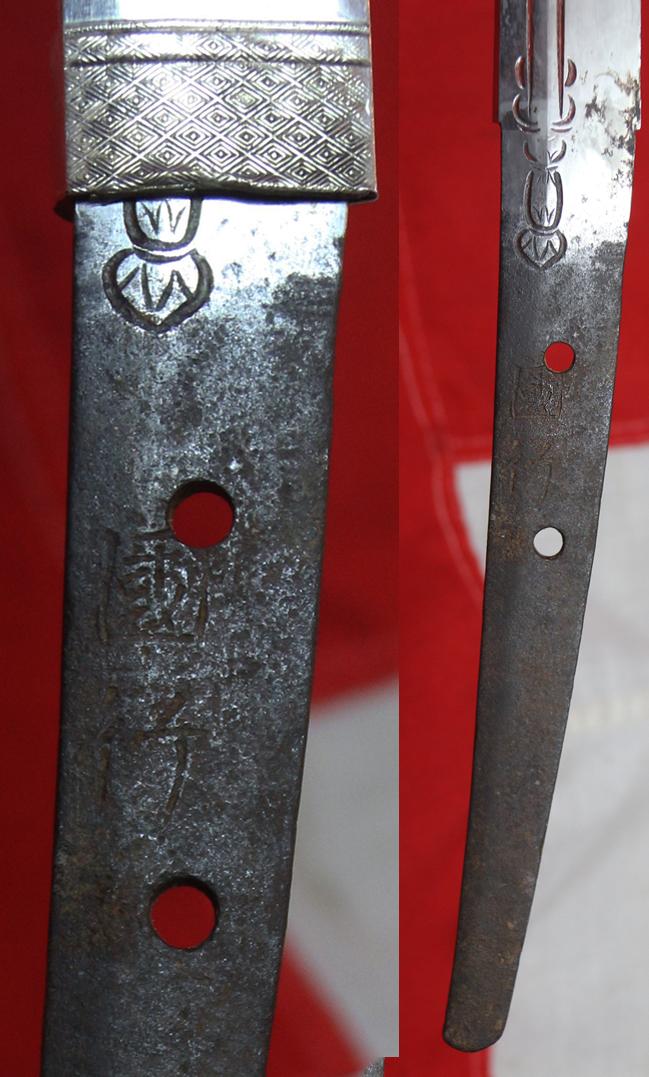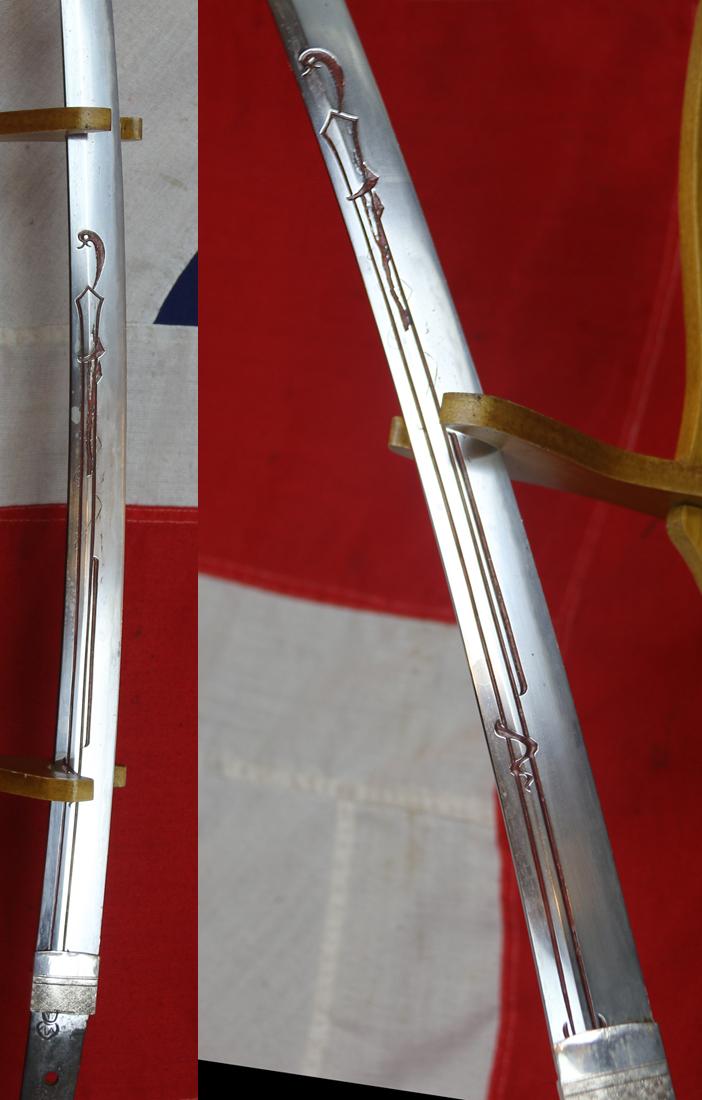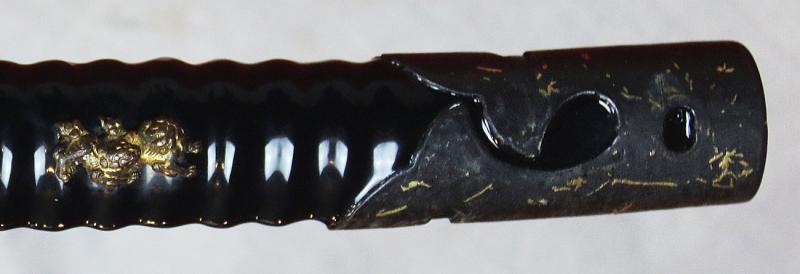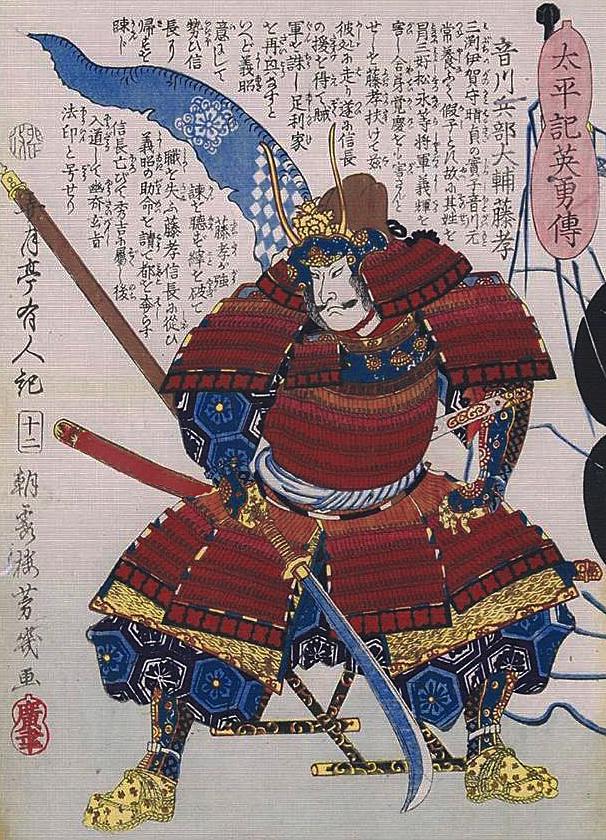A Wonderful, Ancient, Samurai Daimyo’s Tachi Sword, of The Li Clan, With Early So No Kurikara Horimono Carving To The Blade Signed Kuniyuki. Forged in The Kamakura period, 1192-1336 ad.
A stunning ancient tachi bearing a spectacular blade, engraved with the ancient sword of Buddha, somewhere in the region of 800 years old. All original Edo fittings, in iron inlaid with lines of gold, and the hilt kabuto gane pommel is a very unusual and elaborate all enclosing form covering a third of the tsuke. the saya has fine, delicate and rare, light ‘coromandel pink’ urushi lacquer to the saya with a pair of patinated copper ashi for the sageo hanging cord, and a strong contrasting black urushi lacquer to the carved ribbed tsuka. The colour was rewarded to them as the most famous warriors of all the samurai clans of Japan, the Li.
The combination of these original colours of urushi is breathtaking and shows typical Japanese sophistication, combined with sublime elegance. This is truly a prime example of an ancient samurai art sword, where all aspects of its external appearance having been as seriously considered as it’s sublime quality blade craftsmanship. Not the sword of a humble lowly samurai but a daimyo lord of significance, power and certainly style. Possibly even a Daimyo Lord of the Li, known as The Red Devils, of Li Naomasa, one of the most famous samurai warrior lords in Japanese history. Famed throughout Japan as the wearers of the red coromandel pink urushi lacquered armour and swords. A distinction granted to them as the most reliable and fearless of combat warriors. ‘Where the Li went, all others followed’
A photo in the gallery shows the same colour lacquer face armour of Li Naomasa, and woodblock print of a seated daimyo in full armour with his same colour tachi slung across his back. Possibly of a Li daimyo. We also had a full armour of a Li clan samurai, with all the same colour urushi lacquer armour, and also with a very similar menpo face armour.
Early So No Kurikara Horimono carving on the blade, fine original Edo blade polish and the master smith’s signature from around 800 years ago is nicely readable on the most ancient tang.
In Buddhist iconography the symbol of 'So no Kurikara' sword carving represents the defence of religious doctrine and the defeat of falsehood and evil. It is an emblem of intelligence and, by extension, of the victory of spiritual knowledge, which opens the path to enlightenment. Combined with a vajra hilt it signifies the sword of wisdom (e-ken), one of the major attributes of Fudō Myō-ō, also referred to as the Great Immovable One. Fudō was the most popular of the Five Great Kings of Light (Go Dai Myō-ō), deities of Hindu origin who were assimilated into the Japanese Buddhist pantheon in the ninth century.
In the Shingon school of Esoteric Buddhism, Fudō is a manifestation of the Supreme Buddha (Dainichi Nyorai), created to fight evil and champion righteous causes. He is also considered to be the first of the twelve buddhas who receive the souls of the dead and guide them to the eternal care of Dainichi Nyorai. It is possible, therefore, that this ken was made for use in a Shingon ritual devoted to Fudō. Images of Fudō frequently appear in the decoration of Japanese armour and weapons. He is usually shown surrounded by flames, holding the sword, point upward, in his right hand, and the rope (kensaku, with which he binds and nullifies evil, in his left hand.
Another ancient Kuniyuki signed tachi sword is one of the incredible Japanese National Treasures, the finest and rarest of swords kept in Japanese sacred museum collections. It is regarded by all as simply priceless, and, naturally, they will never to be offered on the open market ever again.
Our Kuniyuki sword was not made by that member of the world famed sword smith line, but it is a fabulous speculation to wonder which of the ancient Kuniyuki by whom it was forged, from that era or slightly later.
Another sword, regarded by some as the most valuable in the world, is a samurai sword, estimated to be worth, by its investment fund owners, at one hundred million dollars, therefore, imagine what the Japanese National Treasure. the famed other Kuniyuki tachi might be worth, possibly several times that, but naturaly, it will a question impossible to answer, as it will never be sold.
Tachi was mainly used by an armoured Samurai with one hand on horseback from the Heian period (794-1185 A.D.) until the early Muromachi period. The tachi was the earliest form of sword worn by the samurai, before the katana form was conceived. It is a long sword, suspended loosely on the left waist with its edge facing the ground so that you could draw it faster to cut down soldiers on the ground.
To own such a beautiful ancient sword from so many centuries past of samurai history, is not only an absolute joy, but too many, regarded as a sublime privilege.
It is in many regards an absolute miracle that such ancient and wonderful pieces survive to exist at all today, especially in such incredibly well preserved condition. It is only due to their style never fell out of useable fashion, combined with the Japanese culture based around the bushido of the samurai way of the warrior, where the older a sword was, the more revered and respected it became and thus cared for as the valued and regarded possession of each and every samurai or descendant owner, for anything up to 800 years.
Although an emperor reigned in Japan since ancient times, by the late 1100s powerful military leaders were challenging the power of the imperial court. From the thirteenth century on, Japan was ruled through a dual government structure. While the emperor retained cultural and religious sovereignty over the nation, the military elite during this period assumed political and economic leadership. This system of governance remained in place until the late 1800s.The First Warrior Government (The Kamakura Shogunate, 1185-1333)
By the late eleventh century, the Minamoto (also known as Genji) clan was recognised as the most powerful military clan in the northeastern region of Japan, having defeated several other powerful local groups. In the mid-twelfth century, the Minamoto clashed with the mighty Taira (also known as Heike) clan, which commanded an important western region including the area around Kyoto. A series of clashes, culminating in the Genpei War (1180-1185), ended with the defeat of the Taira.
The victorious Minamoto went on to establish a new, warrior-led government at Kamakura, their eastern stronghold. In 1185 the great Minamoto leader Minamoto Yoritomo (1147-1199) was appointed sei-i-tai shogun ( Great Barbarian-Subduing General; abbreviated as shogun) by the emperor. Yoritomo established a military government, appointing warriors to fill important regional posts as constables or military governors and land stewards. Reporting to the shogun were daimyo provincial landowners who led bands of warrior vassals and administered the major domains
The coromandel pink to red lacquer gosuko was was the symbol of the Li clan, known as the Red Devil’s, of Li Naomasa. Amongst Tokugawa’s most trusted and talented generals was a warrior general called Ii Naomasa. Naomasa was a ferocious warrior, feared and respected equally by friend and foe alike. He was the living embodiment of the samurai ideal. Naomasa and his men would become infamous for wearing blood red armour in battle, earning themselves the nickname ‘The Red Devils,’ with a reputation just as terrifying. The Battle of Sekigahara would be Naomasa’s greatest triumph, as he charged ahead of the main Tokugawa advance to claim first blood against the enemy forces.
The beautiful and original Edo ‘coromandel pink’ colour urushi lacquer to the saya has a few small nicks, but considering it’s age it is in remarkable condition, and as it is such a rare colour, its preservation is an important consideration
Blade just under 28 inches long tsuba to tip, overall in saya 39 inches
Code: 24540
11250.00 GBP









